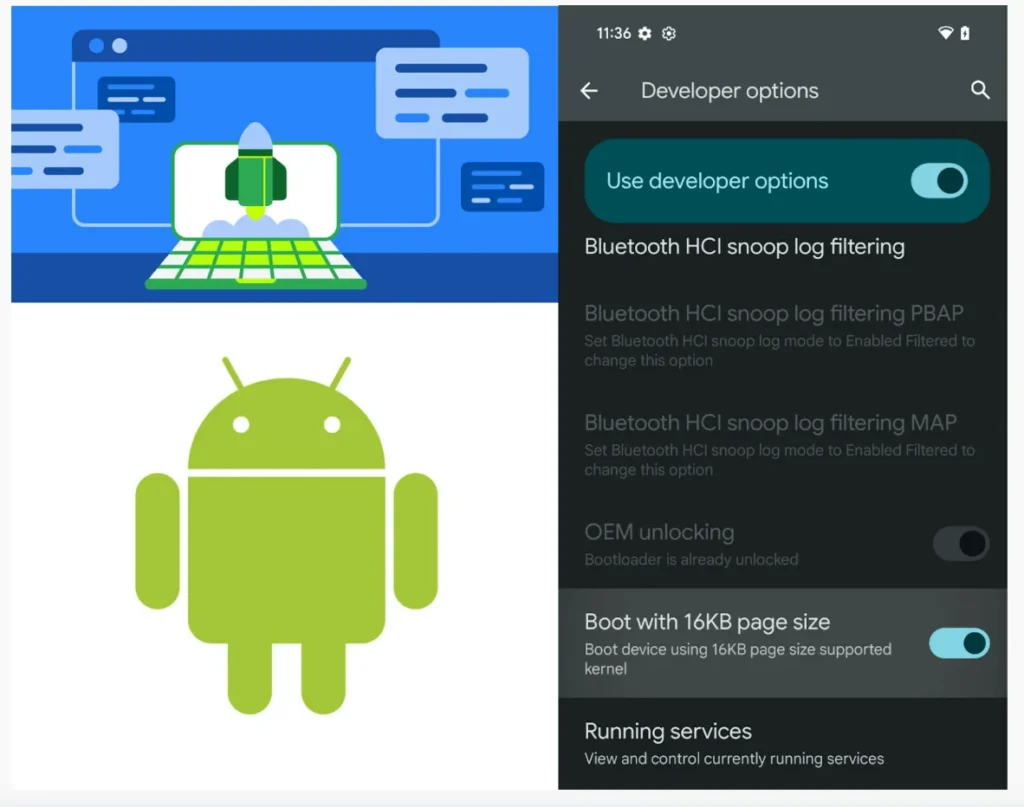
Android has taken a significant step forward by enabling a 16KB page size as a developer option on selected devices, a change that promises to enhance system performance by 5 to 10%. This adjustment leverages the capability of many Arm CPUs, which support 16KB pages, compared to the 4KB page size standard found in most operating systems and CPUs.
Why the Shift to 16KB Page Size?
Most operating systems use a 4KB page size because it aligns with the CPU support in many architectures. However, Arm CPUs, commonly found in Android devices, can handle larger page sizes, including 16KB. By increasing the page size, Android can reduce the number of page entries, which in turn decreases the frequency of memory access interruptions and boosts performance. The larger page size allows for more efficient use of the translation lookaside buffer (TLB), which helps speed up memory access.
Google’s decision to enable this feature comes from the realization that a larger page size can offer tangible performance improvements, especially in devices under heavy memory pressure. However, this performance gain does come at the cost of increased memory usage—approximately 9% more—due to larger pages holding more data.
Key Benefits of the Android 16KB Page Size

Google has outlined several benefits of using a Android 16KB page size on the Android developer website, based on their initial testing:
- Lower App Launch Times: When the system is under memory pressure, apps launch on average 3.16% faster, with some apps seeing improvements of up to 30%.
- Reduced Power Draw During App Launch: The larger page size reduces power consumption during app launches by an average of 4.56%, which can contribute to better battery life in real-world usage.
- Faster Camera Launch: For users who frequently use their camera, the change is particularly beneficial—camera hot starts are 4.48% faster on average, while cold starts are 6.60% faster.
- Improved System Boot Time: The overall system boot time improves by about 1.5%, roughly translating to a 0.8-second reduction.
These performance metrics highlight how the Android 16KB page size option can lead to a smoother, more efficient user experience, particularly in multitasking scenarios or on devices with constrained memory resources.
Compatibility Considerations
One critical aspect of this shift is that, unlike changes from 32-bit to 64-bit modes, a page size is not part of the Application Binary Interface (ABI). This means that once an application is made page size agnostic, it can run on devices using either 4KB or 16KB pages without needing further modifications.
For most apps developed using Java or Kotlin, this transition requires no changes. However, applications that rely on native code (C/C++) or specific dependencies will need to be recompiled to ensure compatibility with 16KB page sizes. Google has provided guidance and tools on its developer website to assist developers in making their applications page size agnostic.

Initial Rollout and Future Availability
Google plans to initially roll out the Android 16KB page size as a developer option on the Pixel 8 and Pixel 8 Pro running Android 15 QPR1 Beta. They are also collaborating with hardware partners to extend this option to other devices, offering a broader opportunity for developers to optimize their apps. Additionally, developers can experiment with the 16KB page size using an emulator target available in Android Studio.
The Linux kernel, which underpins Android, is tightly integrated with a specific page size, requiring a decision on page size during the kernel build process. However, the rest of the operating system remains unaffected by this change, making the transition smoother for most Android users and developers.
Checking Page Size on Linux
For those interested in verifying the page size on their Linux systems, this can be done using the following command in the terminal:
$ getconf PAGESIZE
4096
This command will return the current page size setting, which is typically 4096 bytes (4KB) on most systems.
Conclusion
Android’s shift to a 16KB page size is a significant performance-enhancing move, promising up to 10% better system performance, faster app launch times, and reduced power consumption. By leveraging the capabilities of Arm CPUs, Android can reduce memory access interruptions and boost efficiency. However, this comes at a slight cost of increased memory usage. I believe this change showcases Android’s commitment to innovation and optimization, providing a seamless experience for users. As developers adapt their apps to be page size agnostic, we can expect even more benefits to emerge.
What do you think about Android’s move to a 16KB page size? Will this change impact your device usage or app development strategy?

